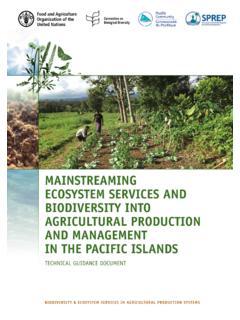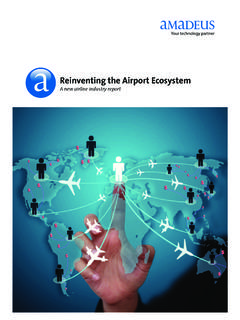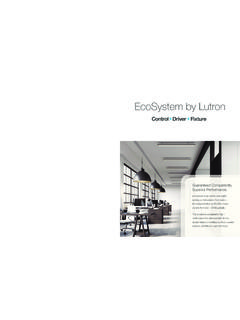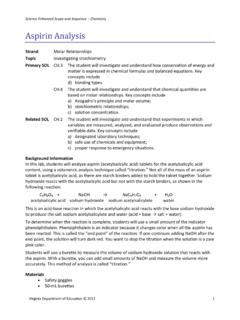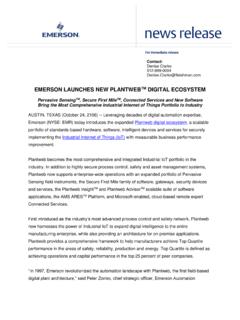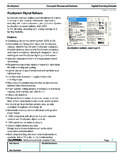Transcription of How to run an ecosystem services walk - PAN UK …
1 NR Group/PAN UK Guidance Note: How to run an ecosystem services walk ---------------------------------------- ------------- This Guidance Note has been developed by The NR Group & PAN UK as one of the outputs for the Darwin Initiative project Pesticide Impacts on Biodiversity in Ethiopia & Agroecological Solutions (DI 1952). It aims to: Outline the Why, What, Who, How, Where and So what? of our experience with ecosystem Service Walks as a practical exercise adapted and tested as part of PAN UK s project & to share it as a good practice tool for participant engagement with others in the Darwin community of practice Provide guidance for use by staff in partner organisations PAN Ethiopia and Institute for Sustainable Development (ISD) to further develop and expand use of this activity, in particular with secondary students in ISD s School Environment Clubs (see Darwin Output Note: Experiences with ecosystem services walks) Inform and inspire a wider audience to undertake similar awareness-raising activities in their work relating to biodiversity enhancement and sustainable management of natural resources Background The basis for Darwin project DI1952 is the ecosystem Approach; the context is Pesticide Ecotoxicology.
2 Training was delivered on the theory behind Taking the ecosystem Approach for the project s core team (CDT) of Ethiopian partners and collaborators during their initial capacity building visit to the UK in month 4 of the project. This covered aspects of and resources from the UN s Millennium ecosystem Assessment, The Economics of ecosystems & Biodiversity (TEEB), the UK National ecosystem Assessment, the ecosystem Knowledge Network and to make these concepts more tangible, participants were led outside for an ecosystem services walk exercise in the Kent countryside surrounding the UK training venue ( ). ecosystem Service walks are one of the tools developed by Dr. Colin Tingle and colleagues and trialled during the DEFRA-funded Chalking up the Benefits project of the South Downs National Park Nature Improvement Area Partnership in the area around Lewes, Sussex ( ). Colin has worked intensively on awareness raising and community-based recognition of the value of ecosystem services in the UK context.
3 In bringing the ecosystem service walks to a tropical audience and to the context of pesticide ecotoxicology, PAN UK was able to make use of the wealth of expertise and field-based experience from our long-standing ecotoxicology consultants, Colin and Prof. Ian Grant. Introduction Diversity and abundance of Ethiopia s Rift Valley migratory birds are declining, particularly wetland species. National experts have suspected excessive pesticide use in nearby flower, cotton and vegetable farming, aerial spraying of granivorous pest Quelea birds and effluent from caustic soda and pesticide formulation factories along lake shores as an important factor affecting wetland ecosystems and the birds that live in them or pass through them. However, data on pesticide volumes entering these ecosystems was scarce as was national capacity lacking to conduct the robust ecotoxicological monitoring required to establish any links between pesticide use and impacts on biodiversity.
4 The PAN UK Darwin project Pesticide Impacts on Biodiversity in Ethiopia & Agroecological Solutions addressed this problem by building capacity for ecotoxicology monitoring, along with broader training and awareness-raising on taking an ecosystem Approach. National food and farming policies have increased reliance on agrochemicals, but without adequate measures to monitor potential side-effects. This gap is likely to impede action to avoid any negative impacts on human and environmental health. Farmers and policymakers are unaware of the economic costs from pesticide harm ( disruption to pollinators and biological pest control) and few Ethiopian stakeholders understand how agro-ecological farming methods which conserve biodiversity can reduce poverty by improving farm income and supporting ecosystem services . Under matched funding from TRAID for improving cotton production and smallholder livelihoods, PAN Ethiopia conducted Farmer Field School training for Integrated Pest Management with almost 2,000 smallholders.
5 This has provided an opportunity to integrate such training and awareness raising to a wide, grassroots audience. The project has included ecosystem Service walks as part of the training/awareness raising, to give a practical, tangible introduction to the ecosystem Approach and its focus on natural capital and ecosystem services . What can ecosystem Service walks do - Aim to provide an introduction to the benefits that people get from the environment and make visible the value of the natural environment to their health, wellbeing and livelihoods + link this to biodiversity, land use and management - Objectives To walk a route through a particular area/site to show as many of the different habitat types that it contains as possible - To prompt people to come up with their own ideas of the benefits that they receive from the place they re in, to share that with others and learn from what they see, hear, feel, smell and touch whilst on the walk , and what they hear from both other walk participants and the walk guide (expert) - To record all the benefits and discuss which ones fit into each of the 4 categories.
6 Provisioning services , Cultural services , Regulating services and Supporting services - Who can lead an ecosystem service walk ? Anyone with a biological and/or sociological background/training can lead an ecosystem service walk , provided they are familiar with the conceptual framework of the Millennium ecosystem Assessment and active in putting the framework into practice. However, walk participants will learn most from one led by someone with extensive experience + understanding of, interest in and enthusiasm to communicate the value of our natural capital and the ecosystem services that flow from it. - Materials needed (or that assist) o Map of route o Briefing sheet on ecosystem services (for example, see BS1 below) o Record sheet for walk (for example, see RS1, below) & Collation sheet (for example, see RS2) How to run an ecosystem Service walk An example of an ecosystem service walk in practice can be found at [ ] Box 1 provides some suggestions for planning a walk .
7 Box 1 How to plan the walk Plan your route What is your site of interest how large is it? How many different habitat types does it contain? ( grassland, wetland, woodland, forest, open water, urban) Aim for a route that is between & 2 km long (depending on time that can be spent) Aim for a route that provides a variety of habitats walk the route; identify stopping points aim for 4-7 points that illustrate different types of ecosystem services ; note key ecosystem service benefits from each site note particularly areas with multiple benefits from one site and/or sites with single (or few) benefits Find an interesting, quiet and attractive place to give an introduction Prepare an introduction to the walk describe the purpose of the walk : to help everyone recognize the benefits we get from our environment and from different types of natural/semi-natural area. Introduce ecosystem services ; introduce natural capital ; mention what we value and what we don t (NB.)
8 Beware cultural differences about this) Find someone to assist you by writing down the benefits people identify and/or film the walk and the discussions Practice the walk with colleagues/friends and/or family (preferably several times, to build confidence) Characterise your audience (who will be on the walk ; what are they likely to know about ecosystem services already; what type of language/vocabulary will work best to engage and inform your audience; what are their key interests likely to be (or they environmentalists? Teachers? School children? Farmers? Business (wo)men?) plan how best to engage their interest Prepare handouts (preferably 1 per person) showing ecosystem services provided by different habitats Prepare record sheets for the walk Prepare collation sheet columns of different ecosystem services types Preparation ecosystem Service walks were not developed as conventional guided walks , but more as means for participatory learning.
9 The starting point is to draw out from the participants the basic ecosystem services that they probably already know about and can identify, such as aesthetic appreciation of natural places, value to them of different landscapes for different recreational activities, the provision of food, the provision of timber and to then encourage thinking outside the box to help them visualize the less obvious ecosystem services such as pollination, climate regulation, water management and flood risk reduction, etc. Guiding the walk - - - - - - - - - - - - - - - - - - - - - - - - - - - - Parting messages ecosystem Service walks are of value in starting to access people to the range of benefits they receive from the natural environment and may be enough in themselves to change people s perspectives and start people thinking differently about the importance of the health of the natural environment to their own wellbeing and to their local economy.
10 It helps to spend a few minutes at the end of the walk repeating some of the key ecosystem service benefits people noticed and mentioned; to emphasise that not all the benefits we get from the environment are visible and that the invisible can be very important; to provide ideas for how individuals can make a contribution to enhancing natural capital and the benefits that flow from it themselves through practical actions (see Follow up, below). Box 2. How to carry out the walk Provide a short introduction to the walk : introduce the place you will be walking and tell people the aims and objectives above (but informally! No mention of Aims or objectives!!) walk to first stopping point. Give everybody 1 minute to look around them Ask everyone to describe the place where you are how would they categorize it? (Wetland? Woodland? Etc.); how large do they estimate the habitat they re in to be? Give everybody 3 minutes to look around and think about how that place is benefitting them Then ask them to tell you what benefits they are receiving from that piece of land/water If it s not clear, then ask them to explain what they mean Encourage them to comment on what others say/suggest as benefits do they feel the same?

